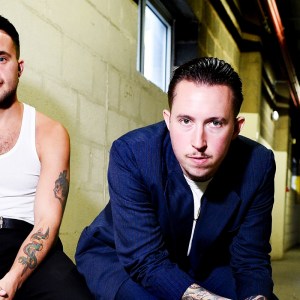Leave it to a couple of schoolmates to call their band after a pyramid-shaped pillar. When first formed in Notre Dame Middle School in Crawley, West Sussex in England in 1973, singer Robert Smith, drummer Lol Tolhurst (who had known one another since they were 5 and first met on a school bus), and three other classmates called themselves Obelisk for one of their first performances.
Videos by American Songwriter
Malice
Changing their name soon after, the teens went with something more malevolent: Malice. As the lineup shifted, the band continued covering their influences like Jimi Hendrix (even covering “Foxy Lady” on their debut Three Imaginary Boys years later) and David Bowie and played their first show in 1976 before changing their name once again to Easy Cure, based on a song Tolhurst had written.
Easy Cure
The first formation of what would become The Cure was Smith, and Tolhurst, along with guitarist Porl (now Pearl) Thompson and bassist Michael Dempsey.
By 1978, Thompson, who later married Smith’s sister Janet, left the band, and Smith insisted they change their name to “The Cure” since he thought Easy Cure was too American.
“I had always thought Easy Cure was a bit hippyish, a bit American-sounding, a bit West Coast, and I hated it, which put Lol’s back up as he’d thought of it,” said Smith in the 1988 book The Cure: Ten Imaginary Years. “Every other group we liked had ‘The’ in front of their name but Easy Cure sounded stupid so we just changed it to The Cure instead. It upset a few old fans but I thought The Cure sounded much more it.”
On July 9th, 1978, the band played their first show as The Cure at The Rocket in their hometown of Crawley.
After Thompson’s departure, Dempsey left and was replaced by longtime bassist Simon Gallup, and began a partly revolving door of bandmates over the decades—with Thompson even returning in 1983 through the early ’90s.
The Cure
Steadily evolving their sound from the more bare-boned punk brevity of Three Imaginary Boys in 1979 with tracks like “10:15 Saturday Night” and “Fire in Cairo,” and stand-alone single “Boys Don’t Cry,” The Cure slowly transitioned into more textured, phantasmic, and lengthier arrangements with the release of one-off single “Charlotte Sometimes,” a precursor to the band’s fourth album, Pornography, in 1982.
Leaning on more pop-y beats for the 1985 release Head on the Door, The Cure started hitting the mainstream harder with the Kiss Me, Kiss Me, Kiss Me hit “Just Like Heaven,” before releasing the masterful tome of Disintegration in 1989, which was followed by one of the band’s jolliest of songs, “Friday I’m in Love,” off the ninth album, Wish, in 1992.
Post-punk, goth, new wave, alt, and pop—The Cure has been categorized as them all, but there’s never been a perfectly sized box to fit them in.
The band today, consisting of Smith, Gallup, keyboardist Roger O’Donnell, guitarists Perry Bamonte and Reeves Gabrels, and drummer Jason Cooper, have released 13 albums in their 40-plus years as The Cure, with a 14th set for release in 2023.
In 2019, The Cure was also inducted into the Rock and Roll Hall of Fame.
Photo: Vince Bucci/Getty Images
